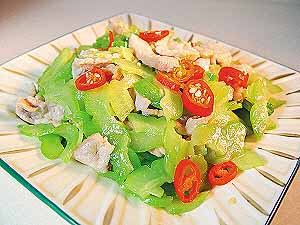提到降低胆固醇的方法,人们通常会想到服用他汀类药物和避免油腻饮食。加拿大研究人员说,只要建立良好饮食习惯,加上有助降低胆固醇的食物,胆固醇水平稍高的人士甚至无需服药。
这一研究结果8月23日由《美国医学会杂志》(JAMA)发表。

JAMA:良好饮食习惯可助降低胆固醇
六月实验
多伦多大学戴维·詹金斯与同事找来351名志愿者,这些人年龄在五十岁上下,胆固醇水平高,平时只吃素。一些人正在服用他汀类药物。
研究人员把志愿者随机分成三组,进行为期六个月的研究。一组人在这期间坚持低脂饮食,另外两组人在营养师指导下多吃有助降低胆固醇的食物,如豆奶、豆腐、坚果、燕麦、豌豆和各种豆类。
营养师建议后两组志愿者每摄取1000卡路里热量就通过植物黄油摄取1克植物固醇,同时还要通过吃麦片、大麦和亚麻籽摄入10克纤维再加上22.5克大豆蛋白和22.5克坚果。
后两组人中,一组人在研究期间接受两次专家指导,另一组接受七次。
研究期间,所有服用他汀类药物的志愿者暂停用药。
效果明显
研究结果显示,六个月后,第一组志愿者体内有害的低密度脂蛋白胆固醇(LDL-C)水平平均下降3%。吃降胆固醇食物的志愿者中,接受两次指导的志愿者LDL-C水平平均下降13%,接受七次的下降13.8%。
从数值来看,研究开始前,志愿者的平均LDL-C数值为170mg/dL。一般来说,LDL-C数值达到160mg/dL就被视为过高。
实验结束时,第一组志愿者LDL-C平均降低8mg/dL,后两组分别降低24mg/dL和26mg/dL,达到正常标准。
英国心脏基金会高级心脏健康营养学家维多利亚·泰勒说:“研究结果令人鼓舞。”
美国全国心、肺、血液研究所说,LDL-C之所以引人关注,是因为这种胆固醇会在血管壁上累积,大大增加患心脏病和中风的几率。
注意饮食
“毫无疑问,他汀类药物在防治心血管疾病方面起到重要作用,”路透社23日引述詹金斯的话报道,“但至少到目前为止,他汀类药物作用有限……实际上,饮食具有强大力量。”
研究人员指出,所有志愿者原本就为降低胆固醇水平控制饮食,饮食健康水平高于一般人群平均值,这是食用降胆固醇食物能取得明显效果的前提。
“如果你想坐在沙发上大吃大喝,看着别人运动而自己无动于衷,那你还是适合靠服用药物来降低胆固醇,”詹金斯说。
美国洛马琳达大学营养学专家琼·萨巴特提醒,利用食物调节LDL-C水平的方法对那些胆固醇水平超过正常值太多的人并不适用,这些人还是需要依靠药物进行调节。
生物探索推荐英文论文摘要:
Effect of a Dietary Portfolio of Cholesterol-Lowering Foods Given at 2 Levels of Intensity of Dietary Advice on Serum Lipids in Hyperlipidemia
ABSTRACT
Context Combining foods with recognized cholesterol-lowering properties (dietary portfolio) has proven highly effective in lowering serum cholesterol under metabolically controlled conditions.
Objective To assess the effect of a dietary portfolio administered at 2 levels of intensity on percentage change in low-density lipoprotein cholesterol (LDL-C) among participants following self-selected diets.
Design, Setting, and Participants A parallel-design study of 351 participants with hyperlipidemia from 4 participating academic centers across Canada (Quebec City, Toronto, Winnipeg, and Vancouver) randomized between June 25, 2007, and February 19, 2009, to 1 of 3 treatments lasting 6 months.
Intervention Participants received dietary advice for 6 months on either a low− saturated fat therapeutic diet (control) or a dietary portfolio, for which counseling was delivered at different frequencies, that emphasized dietary incorporation of plant sterols, soy protein, viscous fibers, and nuts. Routine dietary portfolio involved 2 clinic visits over 6 months and intensive dietary portfolio involved 7 clinic visits over 6 months.
Main Outcome Measures Percentage change in serum LDL-C.
Results In the modified intention-to-treat analysis of 345 participants, the overall attrition rate was not significantly different between treatments (18% for intensive dietary portfolio, 23% for routine dietary portfolio, and 26% for control; Fisher exact test, P = .33). The LDL-C reductions from an overall mean of 171 mg/dL (95% confidence interval [CI], 168-174 mg/dL) were −13.8% (95% CI, −17.2% to −10.3%; P < .001) or −26 mg/dL (95% CI, −31 to −21 mg/dL; P < .001) for the intensive dietary portfolio; −13.1% (95% CI, −16.7% to −9.5%; P < .001) or –24 mg/dL (95% CI, −30 to −19 mg/dL; P < .001) for the routine dietary portfolio; and −3.0% (95% CI, −6.1% to 0.1%; P = .06) or −8 mg/dL (95% CI, −13 to −3 mg/dL; P = .002) for the control diet. Percentage LDL-C reductions for each dietary portfolio were significantly more than the control diet (P < .001, respectively). The 2 dietary portfolio interventions did not differ significantly (P = .66). Among participants randomized to one of the dietary portfolio interventions, percentage reduction in LDL-C on the dietary portfolio was associated with dietary adherence (r = −0.34, n = 157, P < .001).
Conclusion Use of a dietary portfolio compared with the low−saturated fat dietary advice resulted in greater LDL-C lowering during 6 months of follow-up.
Trial Registration clinicaltrials.gov Identifier: NCT00438425
KEYWORDS: cholesterol, cholesterol, ldl, diet, diet, fat-restricted, hyperlipidemias, patient education as topic, randomized controlled trial.







